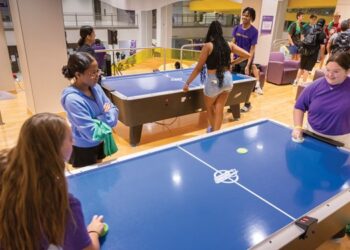Over the past 15 years, the way people exercise has changed tremendously. The recreation center has to adapt if it wants to survive, and so does its designers. The private sector is chasing trends like CrossFit, Orangetheory, cycling studios, yoga studios, and small group training programs are increasing every year. It even leaves you wondering what took them so long, because if you were given a chance to go to a party with a friend or sit alone, most people would choose the party. In addition, technology is making it a prerequisite that your workout be tracked, with the desire of getting results. We all want them; it’s why we exercise in the first place.
In the current climate of ever-raising tuitions and students looking at the debt-to-return-on-investment, how does the recreation center survive? The bigger-is-better mentality is an easy target for administrators and parents, although we all know that potential students are impressed by the large recreation center. So how can it evolve to provide the needed physical and social outlet for students, while maintaining financial viability?
First, look at the current trends in small group training. One personal trainer can run a group of 10 people. If you can charge extra for classes, it’s a revenue stream, desired program and a lower cost for students than one-on-one training. The challenge is the typical recreation center wasn’t designed with large functional training areas, so they either need to be planned for at the beginning or you need to assess what can be removed to create them. These areas should incorporate TRX-type systems, indoor turf, one-on-one props and storage. The beauty of these areas is that they are flexible: As trends change, they can easily adapt.
Second, group class studios are a must. However, you will quickly find the same challenge that the private sector is facing. You need great instructors. Students are like the rest of us, they like and can relate to instructors they connect with. Then they tell friends, and the instructors gain followings. You can use this to your benefit, to help create the social and cultural interaction between students and the rec program, through social media and other programs.
Third, technology interaction between devices like Polar, Fitbit and smartphones makes it easier for students to see what they accomplish, set goals and get results. Don’t underestimate the challenge of seeing where you are tracking against your fellow bikers in a cycling class. Use the technology to track across your different program offerings to create semester challenges and build in incentives. Let it help you create your on-campus community.
While daunting both financially and spatially to an already existing program, think of it from this point of view: Every one of the things that are forcing the evolution of the recreation center are opportunities for your team to interact with the students.
Salvatore Canciello is a principal at S3 Design Architecture Inc. He can be reach at scanciello@s3design-inc.com, or at 781.848.8804.










